Walking in the Rain with a Wagasa Umbrella and Kimono in Kyoto
(How to turn a rainy day into an unforgettable photo experience in Japan’s ancient capital)

- Introduction
- Why Rain Makes Kyoto Even More Beautiful
- What Is a Wagasa Umbrella and Why It Matters
- Why Combine Kimono + Wagasa on a Rainy Stroll in Kyoto
- Best Kyoto Locations for Kimono + Wagasa Photography
- Practical Tips: How to Enjoy Kimono + Wagasa in the Rain
- Why This Experience Stands Out
- Make the Most of Your Session with AllPhotos Kyoto
- Seasonal & Rain-Day Considerations
- Sharing and Maximizing the Final Images
- Common Mistakes & How to Avoid Them
- Conclusion
Introduction
There’s a special magic that descends when rain falls on the old streets of Kyoto, Japan. Combine that with the elegance of a traditional kimono and the artful charm of a wagasa (和傘)—a craft-made Japanese umbrella—and you have more than just a stroll: you have a memory, a photograph, a moment suspended in time.
If you’re visiting Kyoto and want to create something truly unique, the experience of walking through historic Kyoto in a kimono while holding a wagasa umbrella offers you aesthetic, culture, and emotion all in one. And if you’d like to capture that in professional photographs, you’re in the right place: at https://allphoto-kyoto.com/ you can book a kimono photo session that makes rain your ally, not your obstacle.
In this post we’ll explore: why rain enhances the Kyoto experience, what a wagasa umbrella is, how it complements kimono attire, the best photography spots in Kyoto for this combo, practical tips to enjoy it while raining (and how to stay comfortable), and how to leverage the moment to get amazing photos. Let’s dive in.
Why Rain Makes Kyoto Even More Beautiful
When people travel, they often hope for sun. But in Kyoto, a rainy day can amplify the city’s historic aura and create scenes that feel painterly. Here’s why:
Soft Natural Light – Clouds act as giant diffusers. Without harsh sunlight you get fewer shadows, more even lighting, and better portrait conditions.
Reflections & Shine – Historic cobblestones, wooden machiya houses, temple pathways—they all glisten after rain, offering mirrored surfaces and deeper textures.
Atmosphere & Quiet – Rain tends to slow foot traffic. The usual crowds thin out, tea houses are quieter, alleyways more intimate. In Kyoto’s historic districts like Gion or Higashiyama the ambiance becomes gentle and introspective.
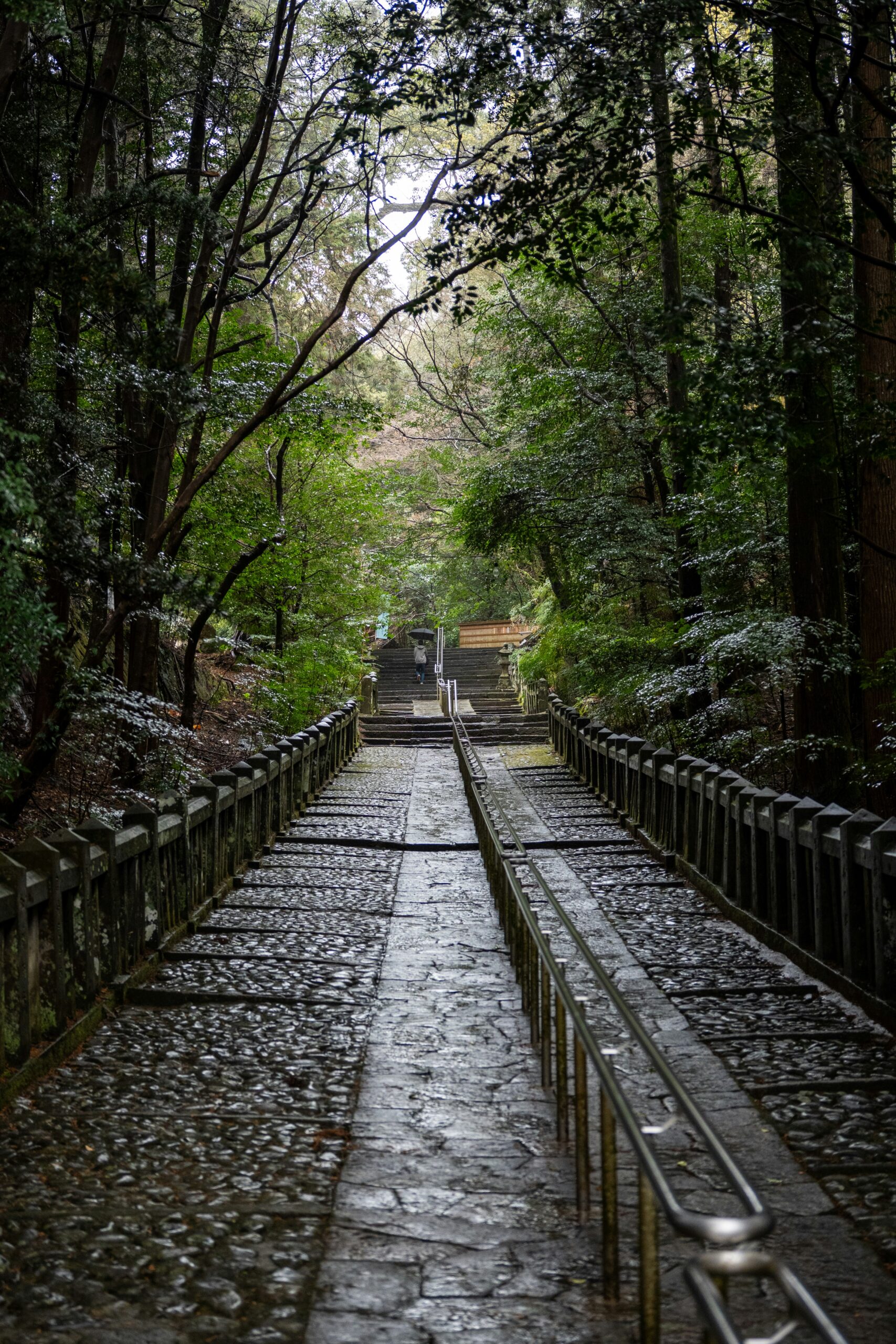
Nature’s Mist & Motion – Rain often triggers mist over temple rooftops or bamboo groves. Leaves drip, stone lanterns gleam. The interplay of nature and architecture becomes vivid.
Cultural Resonance – In Kyoto, walking in rain is normal. Historically, kimono-wearers didn’t cancel their plans simply because it drizzled. Embracing the weather taps into that continuity of tradition.
As one blog about Kyoto noted, the mist rolling over temple rooftops and the gentle rhythm of rainfall transform the city’s visual narrative. And in the case of the wagasa umbrella there is a deep cultural tie: the umbrella is not just functional, but aesthetic.
What Is a Wagasa Umbrella and Why It Matters
When you slip a wagasa into your hand instead of a modern clear umbrella, you’re choosing style, tradition, and symbolism.
Definition & Craft
A wagasa (和傘) is a traditional Japanese umbrella made with bamboo ribs, washi (Japanese paper) often oiled for water-resistance, and lacquered finish. In Kyoto and other historic places the wagasa was used in tea ceremonies, by geisha/maiko, as parasols, and as everyday rain gear before western umbrellas became widespread.
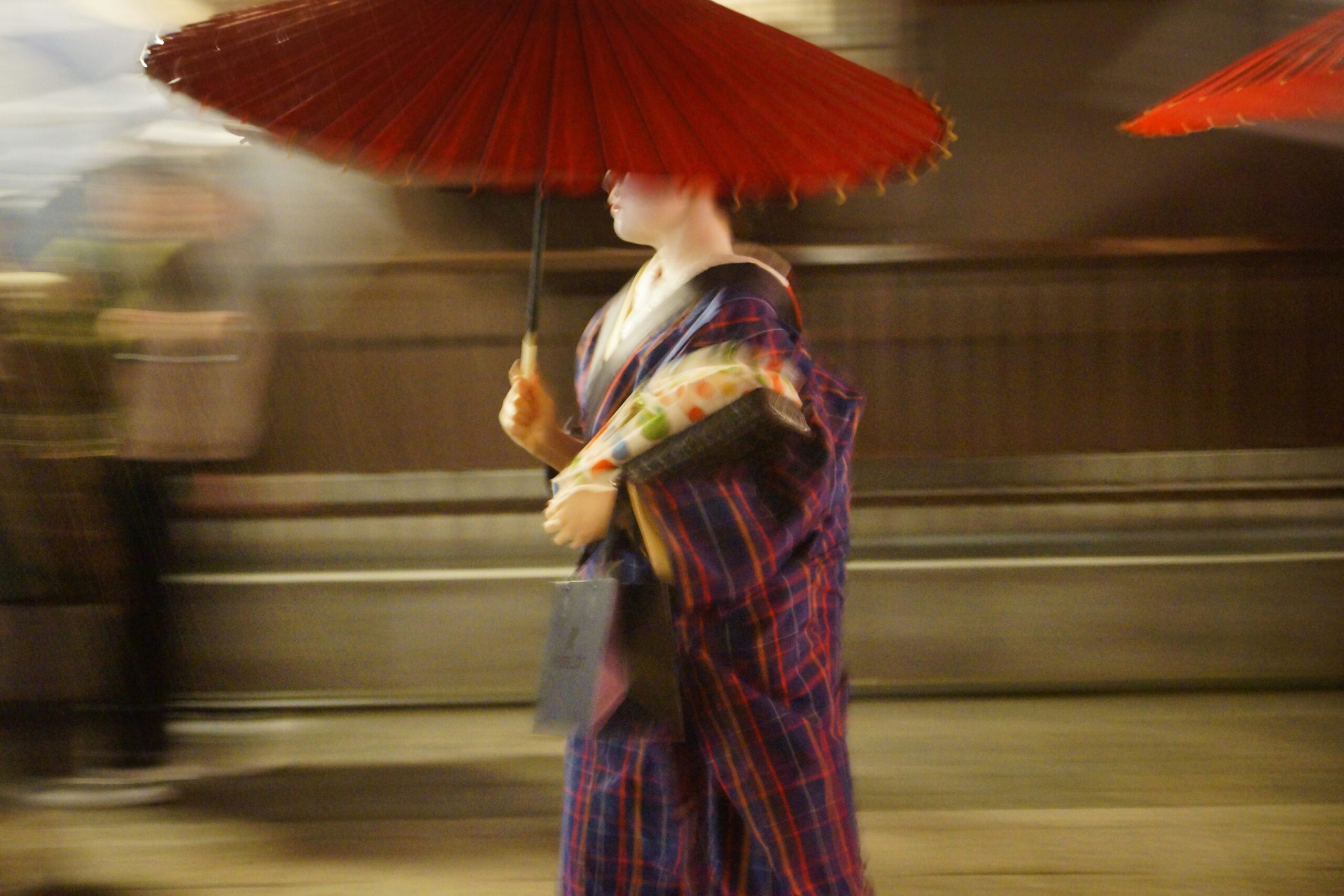
These umbrellas come in several styles:
- Janomegasa (蛇の目傘) – with a ring design around the canopy.
- Bangasa (番傘) – sturdier, everyday version.
- Higasa – parasol for sun protection.
- Odorigasa – used in dance performances.
Why It Works with Kimono and Photographs
Visual Contrast: Imagine a red wagasa umbrella against wet grey pavements in Kyoto, paired with the folds of a silk kimono—color, texture, story.
Cultural Authenticity: When wearing a kimono and carrying a wagasa, you’re evoking a Japan of elegant strolling, of ceremonial calm.
Photography Advantage: The umbrella frames the subject, adds height and shape, breaks monotony, and the rain adds reflective surfaces and atmosphere.
Emotional Impact: Holding a wagasa in the rain feels purposeful—it’s not just coping with the weather, it is part of your experience and narrative.
As one craft-blog said:
“The sight of a person wearing a wagasa umbrella is truly a traditional Japanese beauty.”
Why Combine Kimono + Wagasa on a Rainy Stroll in Kyoto
Let’s break down the benefits and the appeal of this combination:
Aesthetic Harmony: The long lines of a kimono, the umbrella’s canopy, walking posture, wet historic stone—everything composes like a Japanese painting.
Unique Memory: Most tourists avoid rainy days. If you embrace it, your experience and your photos stand out.
Storytelling Depth: You’re not just renting a kimono and walking tourist spots—that’s beautiful already. But when rain enters the picture, you’re telling a richer story: weather, reflection, mood, heritage.
Professional Photography Potential: For your photo session via AllPhotos Kyoto, a rainy day might actually give you more unique shots than a sunny one.
Mood & Emotion: Walking under a wagasa in Kyoto in the rain can feel poetic, introspective, romantic—even cinematic.
Best Kyoto Locations for Kimono + Wagasa Photography
Here are some top spots in Kyoto where a wagasa-and-kimono photo session works exceptionally well—especially in rain.
1. Gion District
The geisha district with narrow alleys, wooden machiya houses, and paper lanterns. After rain, the wet stone pathways reflect the lanterns and create shimmering depth. Strolling here in a kimono with wagasa will feel like stepping into a time when Kyoto nights were lit by lanterns and umbrellas.
2. Kiyomizu‑dera Temple
This UNESCO-site temple perched on a hillside gives majestic views—but the approach and the surrounding lanes also sparkle when damp. The wooden balconies and the misty hills stack perfectly with a candle lantern, kimono, and wagasa for a serene photo shoot.

3. Arashiyama Bamboo Grove
The tall green bamboo stalks form a tunnel of nature. With rain, you’ll hear the rustle of leaves, see droplets on green stems, the path glistening. A wagasa adds a contrasting color and focal point amid the lush green.
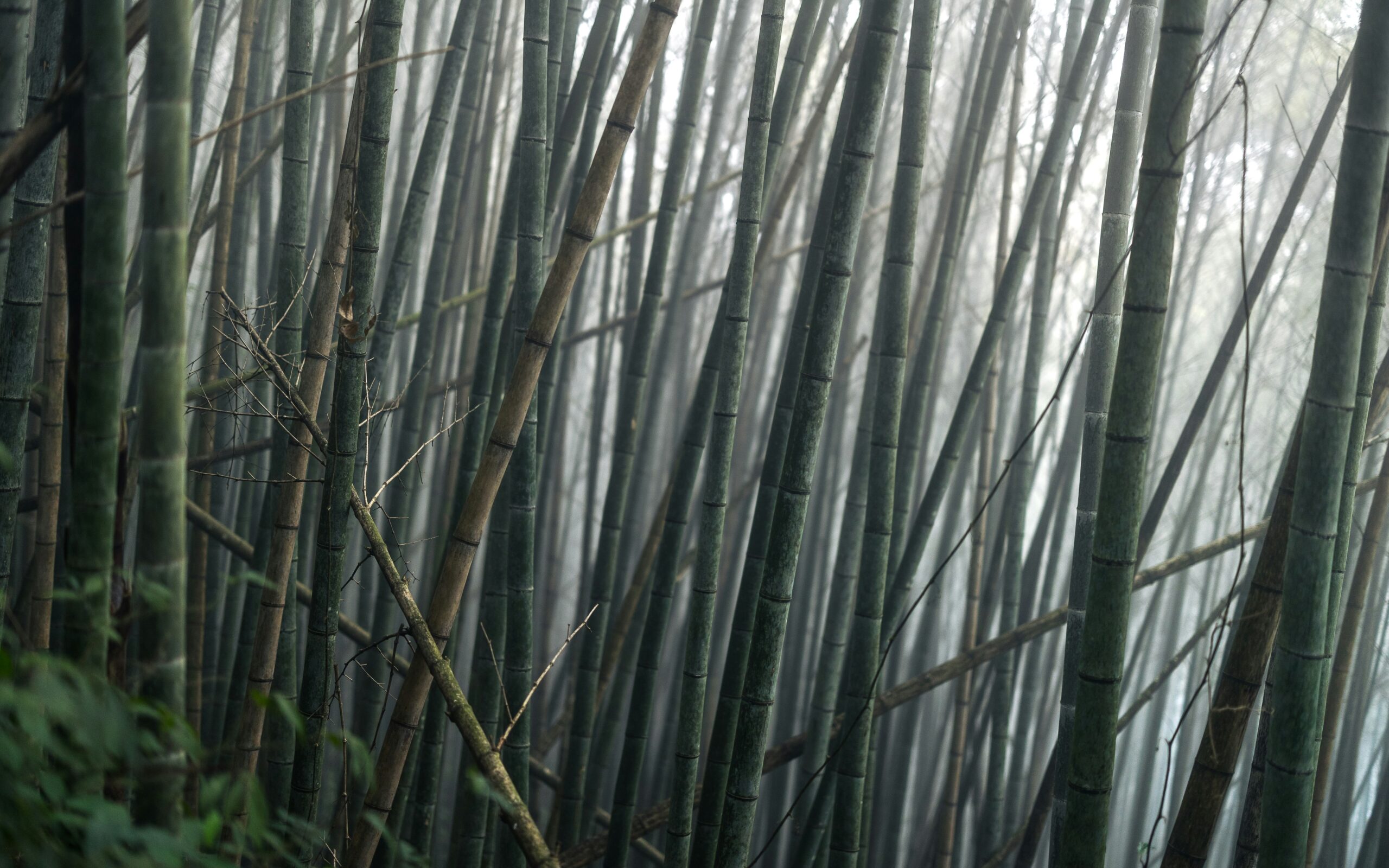
4. Yasaka Shrine
In Gion, this shrine with its vivid vermilion gates, mossy stone, and sacred lanterns is an elegant backdrop. A kimono plus wagasa under gentle rain here creates a striking frame.
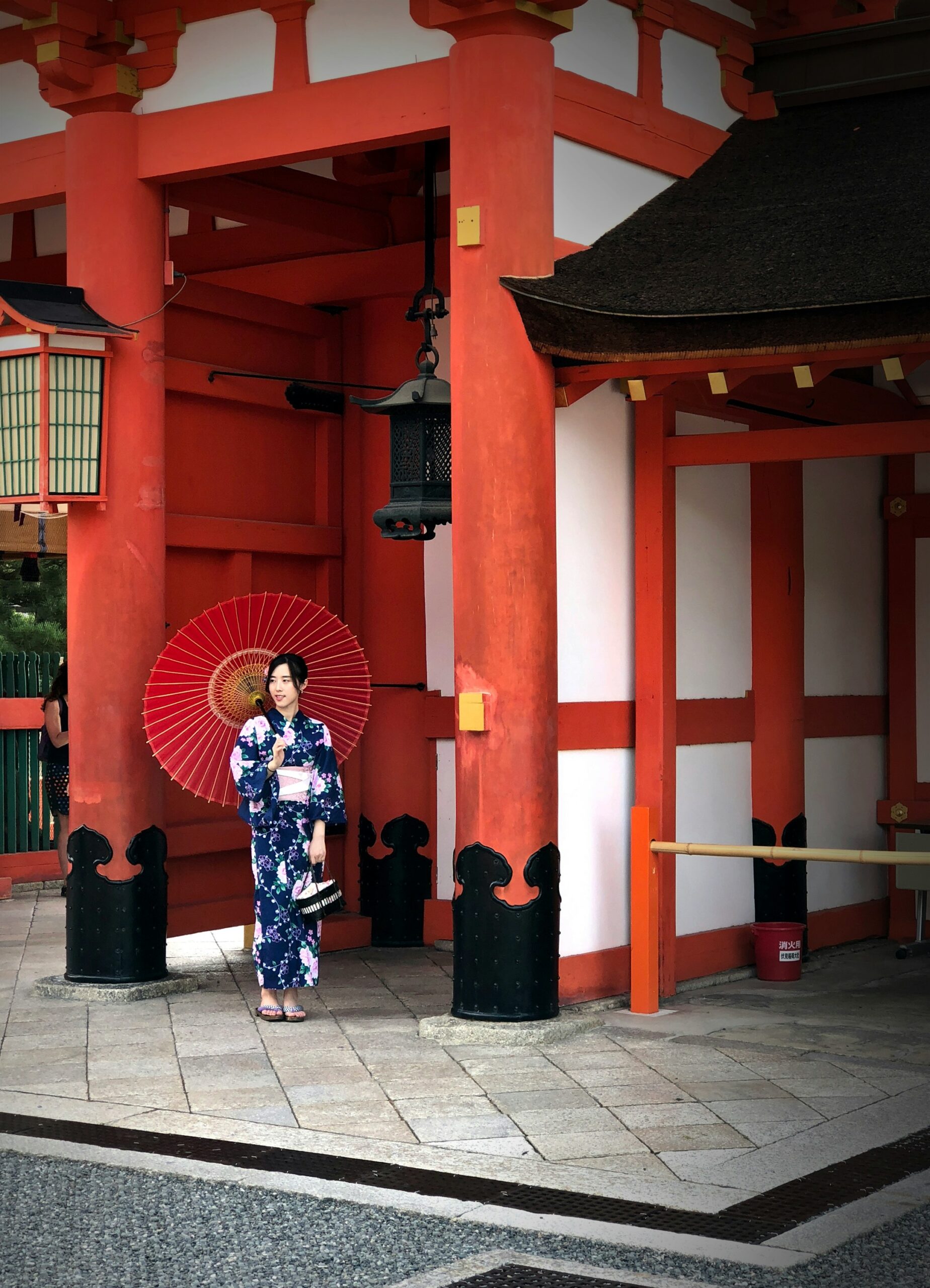
5. Philosopher’s Path
This quiet canal-side path lined with cherry trees and stone paving becomes deeply romantic in the rain. Umbrella overhead, kimono flowing, reflections on the water—ideal for personal or couple photo sessions.
Practical Tips: How to Enjoy Kimono + Wagasa in the Rain
Here are useful, realistic tips to make the most of the experience—even when rain is part of the plan.
Choose the Right Kimono Fabric
- Thicker silk or polyester blends resist light spray better.
- Avoid ultra-thin, fragile fabrics that may cling or become transparent when wet.
- Pick colors that contrast nicely with grey skies and wet stone (deep indigo, burgundy, jewel tones).
Footwear & Accessories
- Wear geta or zōri sandals with tabi socks to maintain authenticity.
- Make sure the soles have some grip—wet stone can be slippery.
- A small modern umbrella can be a backup; use the wagasa for your photos.
Holding the Wagasa
- Wagasa umbrellas are larger and heavier than typical modern umbrellas—tilt slightly so the canopy catches the light and frames your face nicely.
- Hold it at a slight angle to create a dynamic photo composition (not just straight up).
- Let the rain interact: a few droplets, umbrella edge dripping—these add motion and authenticity.
Hair & Makeup
- If you’re renting a kimono with hair styling, mention the rain possibility.
- Waterproof makeup (or at least a touch-up kit) is smart.
- Bring a small towel or handkerchief to dab off umbrella ribs or drops near your face.
Timing & Lighting
- Rainy days tend to diffuse the light—avoid midday glare, choose early morning or late afternoon for best soft light.
- If there is light rain, shoot when the rain has just paused—wet ground, residual puddles, reflections.
- Ask your photographer to use the environment: reflections on pavements, umbrella as framing device, temple lanterns combined with wet surfaces.
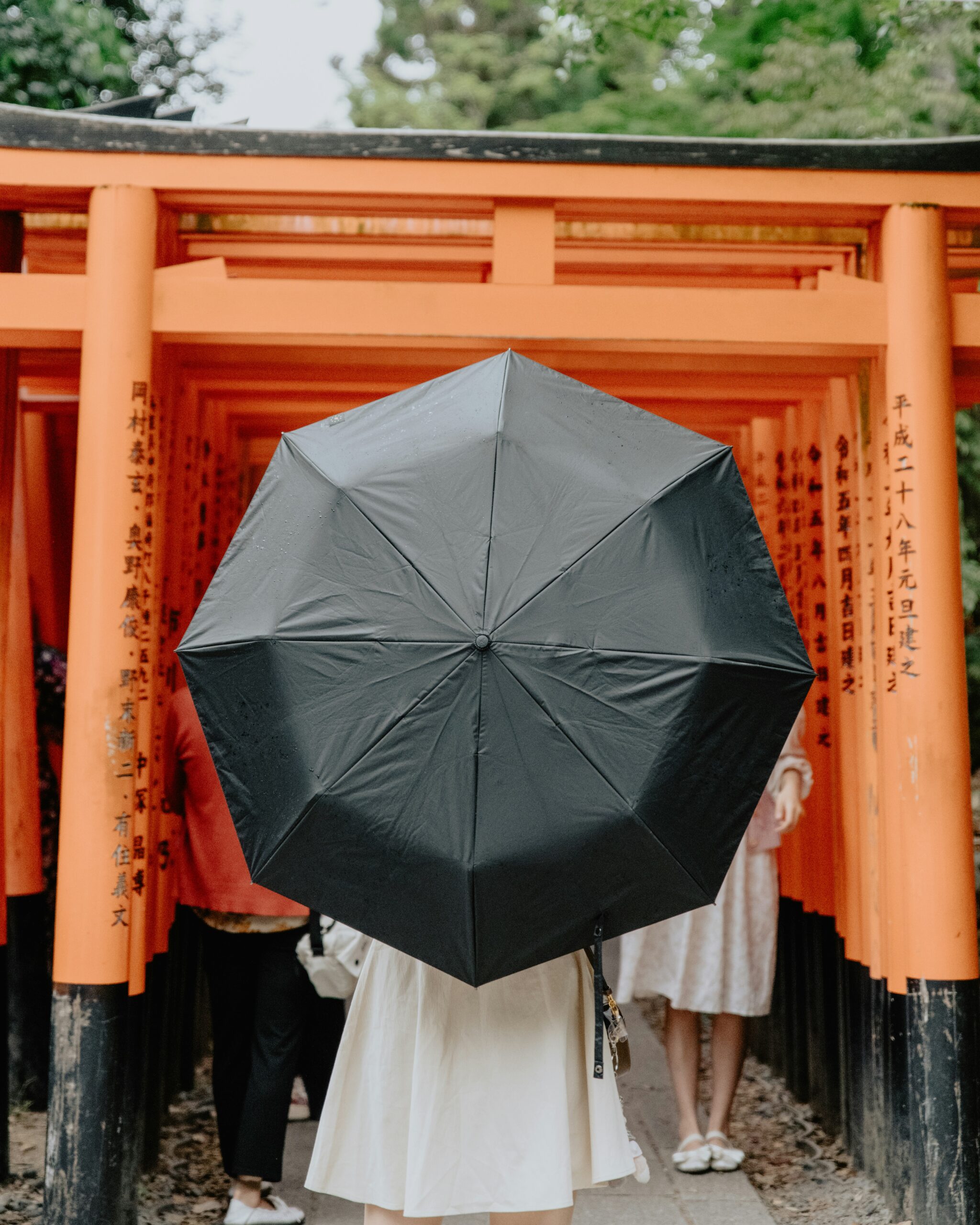
Book Your Photo Session
Make sure to reserve the session ahead of time with the photo studio. At https://allphoto-kyoto.com/ you can secure a kimono + wagasa package and let them know you’re open to rainy-day photography—they’ll plan accordingly.
Mind the Weather, But Don’t Cancel
Sometimes you’ll worry “it’s going to rain, maybe we should postpone.” Instead: embrace the rain. The wet atmosphere can elevate your photos; the decision to go ahead is part of the story.
Why This Experience Stands Out
In a city like Kyoto—rich in historic architecture, gardens, cultural heritage—the combination of kimono, wagasa, rain and photography creates not just a memory but a narrative. Here’s why your experience will stand out:
Unique Visuals: Most travel photos are taken in safe sunny weather. You’ll have something different.
Authentic Feel: You’re participating in tradition—not just wearing a kimono, but interacting with weather the way locals once did.
Emotional Resonance: Rain evokes mood, reflection, calm—qualities that make photos more than just pretty, they become meaningful.
Story-Driven: When you share your photos, the story behind them will include rain, light, umbrella, kimono—and that resonates with viewers and potential clients if you’re sharing on social media.
Professional Edge: With a photo session that actively uses the weather and environment, you’ll end up with higher quality, more shareable content (which also helps your own social or business branding).
Make the Most of Your Session with AllPhotos Kyoto
Here’s how to maximize your booking with us at https://allphoto-kyoto.com/:
- Mention Rain Intent: Let the studio know you’re embracing the rain – they’ll pick locations that shine in that context.
- Select a Wandering Route: Ask for a walking route rather than static shots—this harnesses the dynamic interplay of umbrella, rain drop, kimono movement, reflections.
- Include Wagasa Umbrella Rental: If it isn’t already included, specify you’d like a traditional wagasa umbrella as part of your outfit.
- Pre-Select Some Shots: Browse portfolios and pick a couple of “must-have” shot ideas (walking through Gion alley, umbrella over temple path, reflection on wet stone).
- Plan for Time: Rainy settings might require a bit more time (lighting shifts, surfaces slippery, outfit adjustments) – allow enough session length.
- Request Digital Deliverables: Ask for a set of digital photos you can use for social media, website, print – and consider sharing your experience to boost your own brand or business.
Seasonal & Rain-Day Considerations
Seasonal Impact: In Kyoto, rain in spring brings cherry-blossom petals in puddles; in autumn, leaves reflect in wet stone; winter brings a quiet hush and maybe light snow-mix. Each season adds texture.
Umbrella Color Choice: If the sky is grey, pick a brightly colored wagasa (red, deep purple, indigo) for contrast.
Rain Intensity: Light drizzle or mist often gives the best results. Heavy downpour may force location adjustments or protective layers.
Protecting the Kimono: Ensure you keep a small waterproof cover or plastic slip for the kimono if there is heavy rain or wind.
After‐Care: After the shoot, allow the kimono and accessories to air dry. Wet wooden or silk parts should not be stored damp.
Sharing and Maximizing the Final Images
Once you have your beautiful images, here’s how to get the most value:
Social Media Optimisation: Use the images on Instagram, Facebook, Pinterest with captions like “Kyoto rain walk in kimono & wagasa” – this helps with storytelling and search discovery.
Blog/Website Usage: Embed one or two of your shots in a blog post (like this one) and link to your session – search engines like rich visuals with good metadata.
Hashtags & Keywords: Use keywords like “Kyoto kimono photography”, “wagasa umbrella Kyoto”, “rainy day Kyoto photo session” to enhance SEO.
Print Use: These images can become postcards, prints, or promotional items for yourself or for the studio.
Testimonials: If you enjoyed your session, consider writing a short review for AllPhotos Kyoto – user-generated content helps SEO and credibility.
Common Mistakes & How to Avoid Them
Mistake: Cancelling because of rain. Instead: Reschedule only if heavy storm, but shallow rain or drizzle often enhances the shoot.
Mistake: Using a modern plastic umbrella for aesthetics. Instead: Choose the traditional wagasa umbrella – it adds authenticity and visual impact.
Mistake: Picking high-traffic spots without considering rain lighting. Instead: Prioritize quieter alleys, wet paving, soft light rather than midday sun.
Mistake: Not coordinating outfit and umbrella colors. Instead: Choose kimono and wagasa whose colors complement or contrast the grey sky and wet surfaces.
Mistake: Forgetting practicalities (footwear slip, outfit care). Instead: Ensure comfortable footwear, have a backup umbrella, know how to handle your kimono in rain.
Conclusion
Walking under a wagasa umbrella in a kimono through the rain-kissed streets of Kyoto is not just a travel snap—it’s a moment of culture, beauty, and memory. The rain doesn’t have to be an obstacle—it can be your creative partner.
With thoughtful outfit choice, umbrella styling, location selection, and professional photography through AllPhotos Kyoto, you’ll turn a simple walk into an experience. One that you’ll treasure—and one that will shine online, in your social feeds, on your website, and maybe even in your printed memories.
So next time you see a light shower over Kyoto, don’t hold back—embrace it. Lift the wagasa, let the kimono flow, step into the scene, and let rain transform your journey into a story you’ll want to tell again and again.
Book your session today at https://allphoto-kyoto.com/ and make your Kyoto rainy-day walk the highlight of your visit.
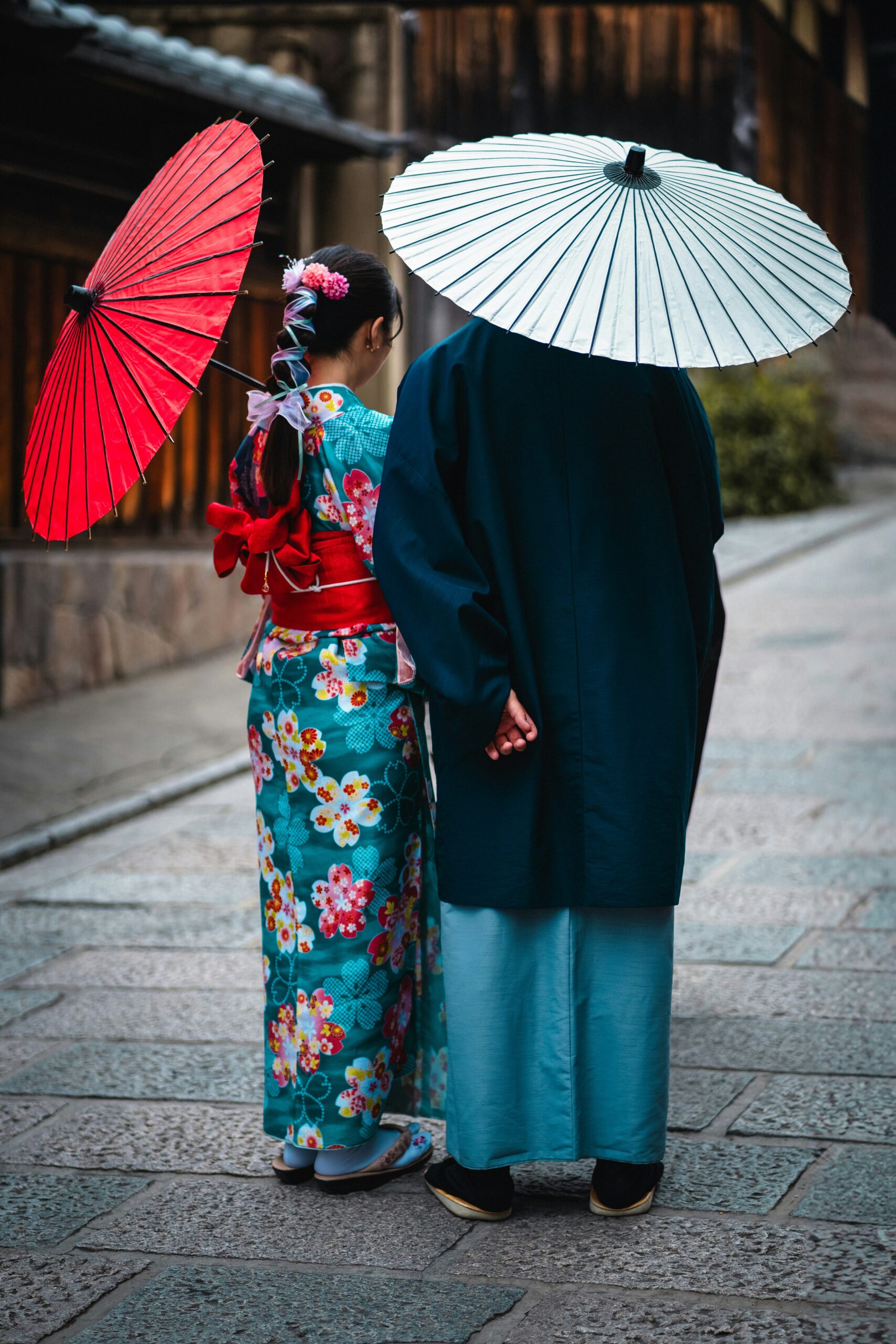

コメント